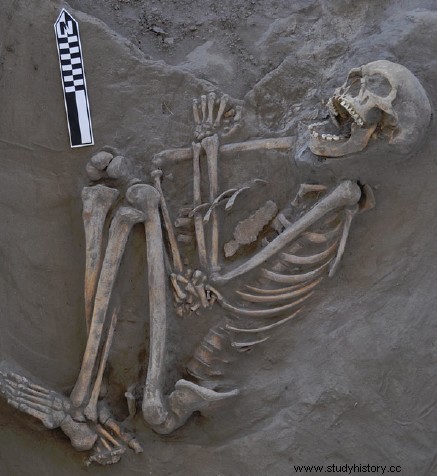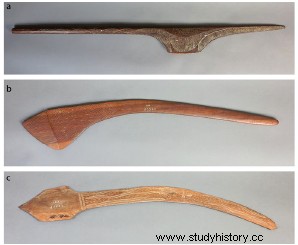 Use of war boomerangs on rock paintings in Gundabooka National Park, near Kaakutja site, Australia .
Use of war boomerangs on rock paintings in Gundabooka National Park, near Kaakutja site, Australia . PROJECTILE. Like a boomerang... This projectile, which has been widespread since prehistoric times, has a variant that is used today by Australian Aborigines and has the property of returning to its launcher. Voluntarily sent by an opponent, it can also prove to be formidable and be used to kill! This seems to have happened in a case dating back to the 13th th century, in New South Wales (Australia).
 The body of the Kaakitja man, found on the banks of the Darling River in the National Park of Toorale. ©Michael Westaway
The body of the Kaakitja man, found on the banks of the Darling River in the National Park of Toorale. ©Michael Westaway
The study of a burial unearthed north of Canberra, in the heart of Toorale National Park, of a young adult in his thirties (the Kaakitja man) whom the Baakantji people of the county affectionately named "Older Brother", does indeed show signs of those traumas usually attributed to metal weapons on his bones. Cuts identical to those left by these sharp objects have indeed been found on the body of this inhabitant of the island-continent, 600 years before the first European settlers - and their metal objects - penetrated inside the 'huge Terra australis.
 Boomerang wounds listed on Kaakitja Man's skeleton. © Michael Westaway
Boomerang wounds listed on Kaakitja Man's skeleton. © Michael Westaway
"These wounds were inflicted by traditional wooden weapons called 'Li-lils', 'Pondee', or 'Mung-un buttaka', as well as battle boomerangs, 'Wonna'. “, explained Michael Westaway, archaeologist from Griffith University (Brisbane), joined by Sciences et Avenir. According to the author of these findings published in the journal Antiquity , the different impacts of the wooden blades correspond exactly to the bone fractures observed on the skull, the frontal bone, the mandible, the right humerus and several ribs of the remains. "Some lesions were older, but others directly resulted in death, confirming the lethality of these aircraft when used as weapons said Michael Westaway. In the past, similar stigmata had been reported on the remains of "the man of Narabeen", another victim buried 3600 years ago. These wounds by spears and boomerangs are described in ethnographic documents relating to violent inter-tribal conflicts.
 Various designs of boomerangs and wooden weapons used in southern Australia. ©Michael Westaway
Various designs of boomerangs and wooden weapons used in southern Australia. ©Michael Westaway
War themes that can also be found in the cave paintings adorning Australian rock shelters (opening photo). "Boomerangs used for hunting and warfare were considerably larger and heavier, with a wider curvature and very sharp blades reminiscent of sabers “said Michael Westaway. Fighting boomerangs made to kill. Lethal weapons.
